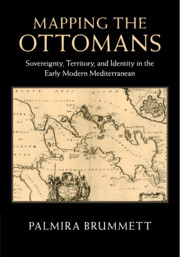Crossref Citations
This Book has been
cited by the following publications. This list is generated based on data provided by Crossref.
Kadercan, Burak
2017.
Territorial design and grand strategy in the Ottoman Empire.
Territory, Politics, Governance,
Vol. 5,
Issue. 2,
p.
158.
Anae, Nicole
2018.
Visual Imagery, Metadata, and Multimodal Literacies Across the Curriculum.
p.
77.
Rega Castro, Iván
2018.
The “new Lepanto”? John V of Portugal and the battle of Matapan (1717).
Journal of Iberian and Latin American Studies,
Vol. 24,
Issue. 1,
p.
93.
Clines, Robert John
2019.
A Jewish Jesuit in the Eastern Mediterranean.
O’Neill, Ciaran
2020.
Researching Elites and Power.
p.
159.
Cayli, Baris
2020.
Crime, bandits, and community: how public panic shaped the social control of territory in the Ottoman Empire.
Territory, Politics, Governance,
Vol. 8,
Issue. 3,
p.
356.
UĞUR, Yunus
2020.
Tarihsel Kaynaklar, Temsil ve Osmanlı Şehirleri: 937/1530 Tarihli Muhasebe-i Vilayet Defterleri’ni Dönemin Benzeri Kaynakları Arasında Konumlandırmak.
Divan: Disiplinlerarası Çalışmalar Dergisi,
Cahill, Samara Anne
2020.
Anglo‐Muslim relations in 18th‐century literature and culture.
Literature Compass,
Vol. 17,
Issue. 10,
p.
1.
UĞUR, Yunus
2020.
Tarihçilikte “Mekânın Yeniden Keşfi”: Osmanlı Şehir Çalışmaları İçin Öneriler.
İDEALKENT,
Vol. 11,
Issue. 30,
p.
678.
Dursteler, Eric
2022.
Language and Gender in the Early Modern Mediterranean.
Renaissance Quarterly,
Vol. 75,
Issue. 1,
p.
1.
Maier, Jessica
2022.
Cartography and Breaking News: Mapping the Great Siege of Malta.
Renaissance Quarterly,
Vol. 75,
Issue. 2,
p.
459.
Yanık, Lerna K.
2023.
The making of Turkish exceptionalism: the west, the rest and unreconciled issues from the past.
Turkish Studies,
Vol. 24,
Issue. 3-4,
p.
640.
Constantinescu, Ştefan
2023.
Misunderstandings and mastery: cartography of the lower Danube during the enlightenment era (1768–1774).
GeoJournal,
Vol. 88,
Issue. 6,
p.
6259.
Yıldırım, Duygu
2024.
Back to the future: a belated history of ‘new’ science in the Ottoman Empire.
BJHS Themes,
p.
1.
Bayındır, Cem
2024.
KARADENİZ’E YÖNELİK RUS GENİŞLEMESİ VE COĞRAFİ HARİTACILIĞININ ETKİSİ: CORNELİUS CRUYS’UN 1699 YILINDA HAZIRLADIĞI “DON NEHRİ ATLASI” ÇERÇEVESİNDE BİR DEĞERLENDİRME.
Karadeniz Araştırmaları,
Vol. 21,
Issue. 82,
p.
341.
Iqbal, Muhammad Sajid
Shahzad, Muhammad
Ahmed, Nauman
Akgül, Ali
Ghafoor, Madiha
and
Hassani, Murad Khan
2024.
Optimum study of fractional polio model with exponential decay kernel.
Scientific Reports,
Vol. 14,
Issue. 1,
Holmberg, Eva Johanna
2025.
Writing Mobile Lives, 1500–1700.



